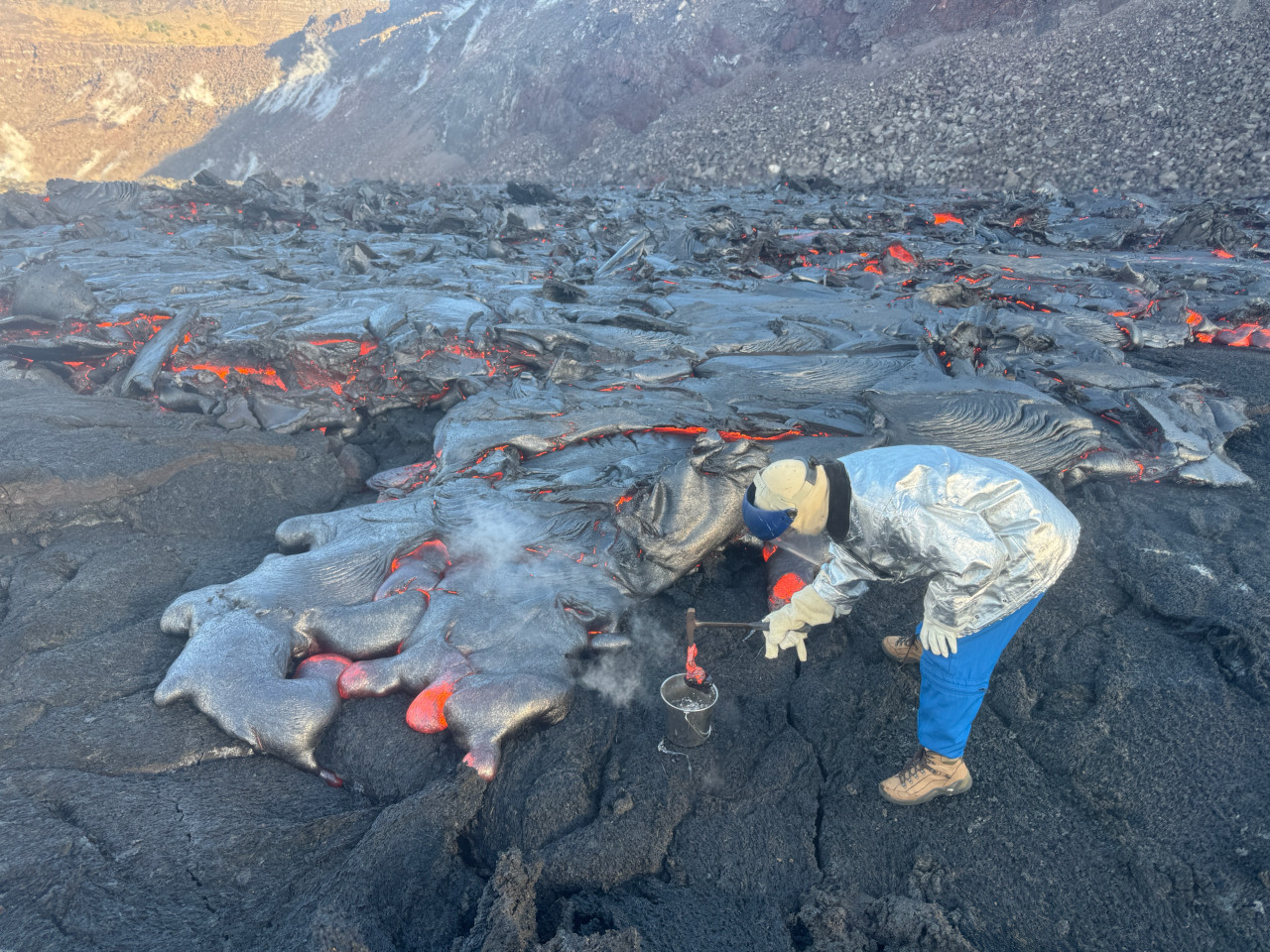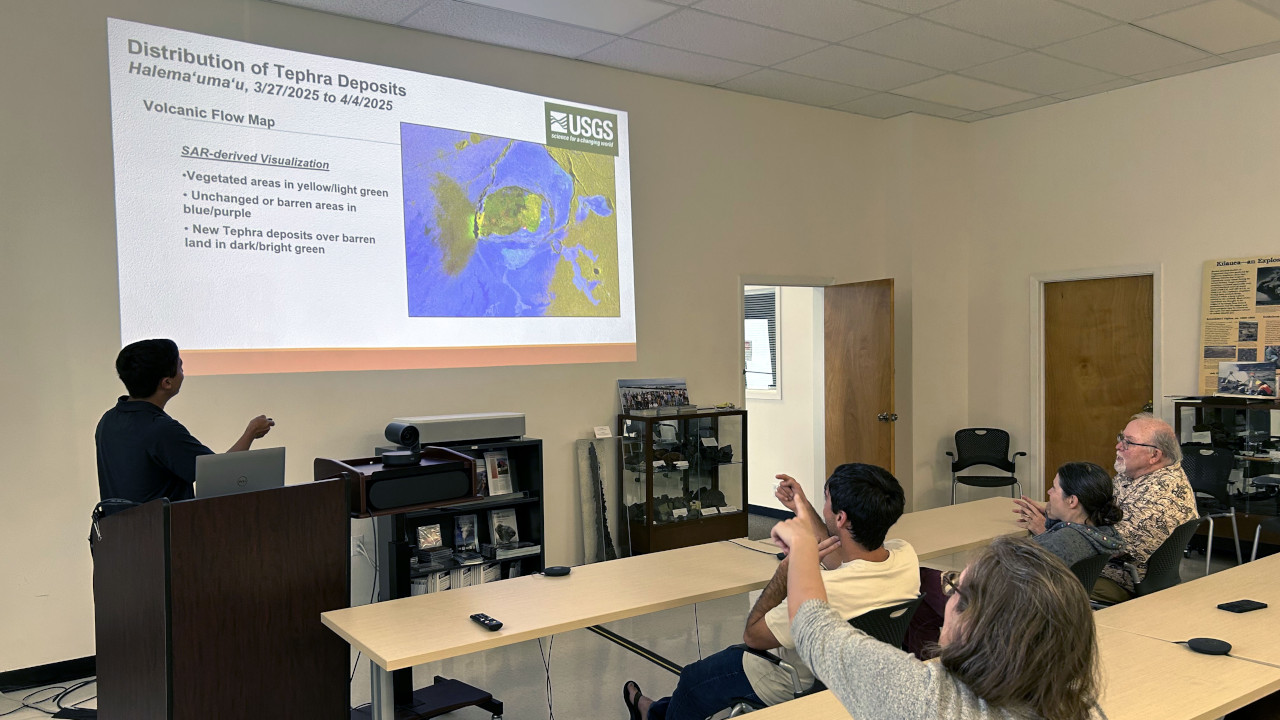(BIVN) – The eruption at the summit of Kīlauea volcano remains paused, with another episode likely to begin in the next 3 to 6 days. The USGS Volcano Alert Level for Kīlauea remains at WATCH.
Scientists with the USGS Hawaiian Volcano Observatory continue to monitor Kīlauea around the clock, and the latest Volcano Watch article focuses on the National Volcano Information Service.
From this week’s article, written by Thomas-Jon Hoomanawanui, HVO Systems Administrator:
The National Volcano Early Warning and Monitoring System (NVEWS) was first authorized by congress in 2019 to be established within the United States Geological Survey (USGS). NVEWS serves as a critical framework for how the USGS monitors volcanic activities across the nation so as to provide timely warnings and protect citizens from potential hazards associated with volcanic eruptions.
NVEWS, when fully implemented, will operate through an interoperable network of domestic volcano observatories and utilize advanced technological tools. Central to the success of NVEWS will be the National Volcano Information Service (NVIS), which aims to be the backbone for data management and analysis within the system. NVIS will be an indispensable component of NVEWS, integrating cutting-edge information technology (IT) solutions to ensure efficient monitoring, accurate data interpretation, and effective communication of volcanic hazards.

USGS: “A USGS Hawaiian Volcano Observatory geologist collects a molten lava sample for geochemical analysis, which will inform hazard analyses of the ongoing eruption. This lava flow was supplied by lava fountaining in the western end of the crater, during episode 17 of the ongoing summit eruption of Kīlauea.” (USGS photo by M. Patrick)
NVIS will be responsible for collecting, aggregating, storing, and distributing vast amounts of volcano monitoring data from across the country, including earthquake activity, ground deformation, gas emissions, and other phenomena associated with volcanic unrest. NVIS aims to not only integrate data generated directly by volcano observatories (e.g., local instrumentation and on-the-ground measurements), but also satellite imagery provided by partner agencies including the National Oceanic and Atmospheric Administration (NOAA) and National Aeronautics and Space Administration (NASA).
For instance, several NOAA satellites provide critical thermal imaging capabilities important for ash and hot-spot detection, while satellite missions operated by NASA and other parties can provide detailed radar observations of volcanic terrains. These technologies enable continuous monitoring of volcanic activity, even in remote or hard-to-reach locations. The integration of satellite data with future and existing ground-based sensors will ensure that NVIS has a comprehensive view of volcanic conditions.
NVIS IT systems will need to be robust, capable of ingesting and processing large data streams in real-time, which will require sophisticated storage solutions and efficient database management systems. NVIS must employ advanced technologies to potentially utilize petabytes of information (equivalent to about a thousand terabytes or a million gigabytes!), ensuring that historical data is preserved and accessible for analysis. NVIS will leverage scalable cloud-based storage solutions where applicable, given the exponential growth in data generated by increased volcanic monitoring efforts.
The success of NVEWS depends on the ability to distribute timely and accurate information to stakeholders. NVIS will play a key role in ensuring that this happens through user-friendly interfaces and standardized software tools. For example, online platforms, provided via NVIS, will be accessible to academic researchers, government agencies, and even the general public. By providing a common set of information systems and tools, NVIS can enable scientists and decision makers to work together seamlessly, regardless of their physical location. This collaborative environment is crucial for analyzing complex volcanic datasets and developing actionable insights.
One of the most significant contributions of IT to the success of NVIS lies in its ability to support real-time analysis and predictive modeling. NVIS is expected to utilize statistical and machine learning algorithms to enable the processing of data streams, identifying patterns, and forecasting potential volcanic eruptions with increased accuracy. These advanced analytical techniques allow scientists to detect subtle changes in volcanic behavior that might otherwise go unnoticed. The integration of advanced IT solutions into NVEWS will be instrumental in transforming volcano monitoring into a cohesive national endeavor. By leveraging cutting-edge technologies such as satellite imaging, machine learning, and remote collaboration tools, NVIS improves the likelihood that volcanic threats are detected early and managed effectively.
Ultimately, the success of NVEWS will hinge on its ability to harness technological advancements for the benefit of public safety. Through continuous innovation and collaboration, NVEWS aims to improve upon the already-high-caliber volcano monitoring programs within the USGS in a new era of technology, ensuring that citizens are as protected as they can be from volcanic hazards.
As technology continues to evolve, so too will NVEWS and its reliance on advanced IT solutions. These advancements will ensure that NVIS and NVEWS can fully transform scientific efforts into tangible benefits for society as an indispensable ally in the USGS’ ongoing efforts for a safer nation.


by Big Island Video News8:35 am
on at
STORY SUMMARY
ISLAND OF HAWAIʻI - The NVIS will be the backbone for data management and analysis within the National Volcano Early Warning and Monitoring System.